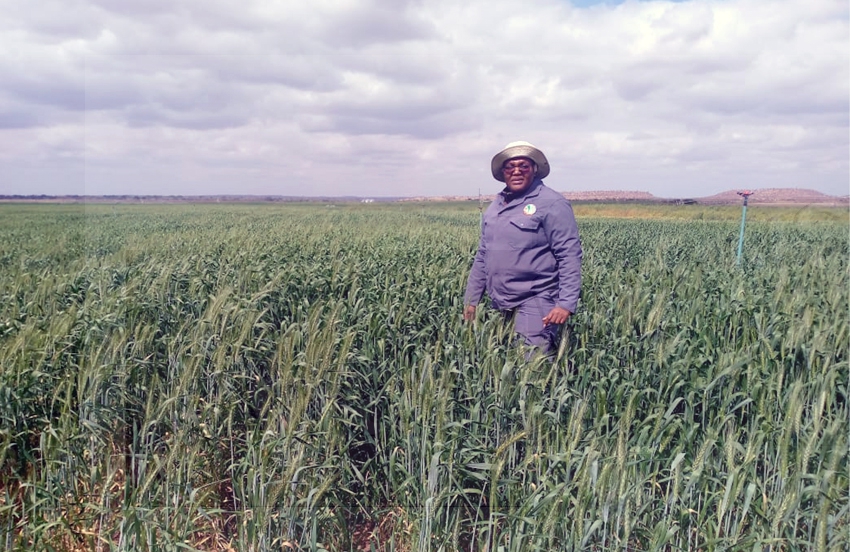Leopard ecology and conservation project ...of predator ecology and human-wildlife conflict 1
16 Oct 2024
Stretching across the wild and untamed sands of the Kgalagadi, where time slows beneath the relentless sun, a team of committed wildlife conservationists is on a mission.
One of them is Ms Monika Schiess-Meir. The year is 1998 when together with her team, they venture into the desert. Their mission is to unravel the mysteries of two of nature’s most powerful predators - the elusive leopards and the majestic lions.
Their quest is to foster a better understanding of these secretive creatures to address the challenges of human-wildlife coexistence with the ultimate aim of safeguarding the delicate balance of the Kgalagadi ecosystem and ensuring a future for all its inhabitants.
While her plan was to study leopard behaviour for three years, little did Ms Schiess-Meir know that the timeless sands of the desert would capture her heart while her three-year study would evolve into a lifelong mission to preserve the fragile coexistence between humans and wildlife.
As she accompanied the trackers, she was enthralled by their almost spiritual connection with the land, observing how they deciphered hidden clues in the sand or extracted water from the most unexpected places, sustaining life in this unforgiving desert.
Ms Schiess-Meir would henceforth realise that the key to preserving this delicate balance lay in the union of science and tradition. With her team’s scientific knowledge coupled with the trackers’ generational wisdom, new ideas and innovative approaches blossomed, heralding the birth of the Leopard Ecology and Conservation Project.
The project, a union of the old and the new, of Western knowledge and African traditions, set out with a singular purpose: to create a harmonious ecosystem where both humans and wildlife could thrive.
Since its inception in 2000, the Leopard Ecology and Conservation Project has served as a steadfast beacon of hope in the Kgalagadi, providing employment for about 27 locals. Among them is Mr Pogiso Africa, who was relocated from the Central Kalahari Game Reserve (CKGR) to Kaudwane in 1995 during the Basarwa relocation exercise. Today, he is a Research Assistant and the Head of Trackers for the project.
Mr Africa and his colleagues brought with them a wealth of knowledge, passed down through generations of living on the land, making them invaluable assets in the conservation efforts.
However, the project’s scope expanded beyond leopards in 2004 when lions, drawn by the allure of livestock, began to pose a threat to farmers and their livelihoods. The farmers, in turn, retaliated by killing these predators.
Realising the fragility of the ecosystem, Ms Schiess-Meir and her team quickly expanded their outreach, educating the local communities about the importance of their livestock and the critical role that these predators play in maintaining a healthy environment.
For Mr Africa and his team, the struggle to maintain a delicate balance between predators and farmers had been ongoing for years. The erection of a protective fence in 2008 seemed like a ray of hope, a buffer to keep both humans and wildlife safe. But as the saying goes, even the best-laid plans can unravel and so it was with this fence.
Mother Nature, never one to be contained, sent her elephants to tear down the barrier. In an unfortunate twist, some local people, seemingly unaware of the consequences, took it upon themselves to cut the fence, allowing predators to escape.
The results were dire. Predator numbers plummeted, and farmers once again found themselves in a struggle with nature. As Mr Africa recounts, “Just this year alone, we lost four lions. The number of predators has significantly declined”.
Currently, the project has seven collared lions that they are monitoring. The dwindling numbers, brought about by human-wildlife conflict and the fragility of the ecosystem, threatens not just the survival of these apex predators, but also the tourism industry that relies on them as a key draw for visitors. The delicate balance between conservation, human development and the health of the wildlife population hangs in the balance, posing a dire challenge for Mr Africa and his colleagues.
As the Leopard Ecology and Conservation Project grew, so did its scope and complexity. The team quickly realised that their efforts must extend beyond the preservation of wildlife and into the realm of community development, education and social science.
Community Conservation Project officer, Mr Ernest Gagosimologwe, a colleague of Mr Africa and another Kaudwane native, highlights the introduction of the Leopard Ecology Community and Education programme which has a team of 20 residents and individuals with expertise in community-based conservation.
“We seek to improve the livelihoods of the community, establish small-scale businesses and provide education on the importance of conservation,” he explains.
To aid the farmers and herders in Kaudwane and surrounding areas, the Leopard Ecology and Conservation Project implemented a multi-pronged approach.
Twice a week, the team would visit remote cattle posts to gather information about livestock predation, disease and overall health. Armed with this knowledge, they would return to the farmers and herders to provide practical solutions for reducing predation, including livestock management trainings and an “off trimming project” that helped maintain the health of livestock by trimming overgrown hooves.
They also work with Kaudwane residents in several community projects such as an organic vegetable garden, a community conservation club, a solar cooker project and a tree project. Through the tree project, they plant 250 trees annually.
The Leopard Ecology and Conservation Project team continued to expand its efforts to support the community in Kaudwane through various initiatives funded by their corporate social investment programme.
Such initiatives included efforts to promote waste management and protect the environment, sponsorship of local sports activities, educational sand tracking and satellite tracking demonstrations and partnerships with the Department of Veterinary Services to vaccinate domestic animals against rabies.
The team’s dedication to creating a harmonious relationship between humans and wildlife extends beyond the local community to the larger CKGR settlement, demonstrating its commitment to the well-being of both people and animals.
The Leopard Ecology and Conservation Project stands as an embodiment of the transformative power of collaboration, bridging the gap between tradition and modernity, between nature and man, weaving a story of hope and sustainability for generations to come. ENDS
Source : BOPA
Author : Lindi Morwaeng
Location : KAUDWANE
Event : FEATURE
Date : 16 Oct 2024





